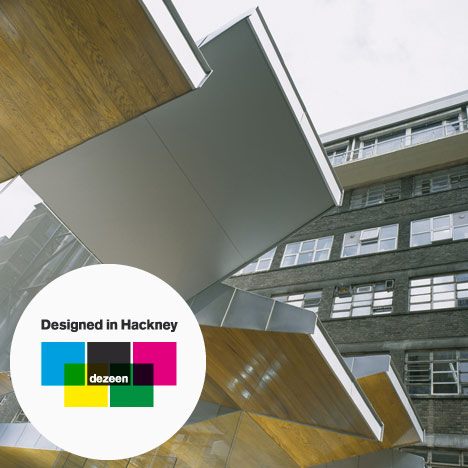Designed in Hackney: next up in our Hackney design showcase is a conservatory with a five fingered roof that Shoreditch architects Spacelab installed at London's Great Ormond Street Hospital in 2004.
Located on top of a boiler house, the Orangery provides a dining room for both staff and patients at the hospital, as well as a space for temporary exhibitions or events.
Some of the the zinc and wood-covered fins that comprise the roof are angled upwards to draw light in through the glazed facade, while others are slanted downwards to create overhanging canopies.
Gaps between the different sections of the roof are also glazed, creating a row of high-level windows.
The wooden ceiling surfaces wrap down around the walls and floor, then extend beyond the facade to become stripes on the terrace outside.
Here's some more text from Spacelab:
The Orangery, designed and built by award-winning architects, Spacelab was completed in August 2004 and picked up an influential RIBA Award in 2005. The architects’ brief was to create a ‘conservatory type building’ providing both an internal and external area for dining and drinking and SpacelabUK delivered an inspiring and exciting contemporary space, which hugely differs from a normal hospital canteen experience.
Set on the existing boiler house roof, the Orangery is a modern sculptural pavilion and a dramatic transformation from a forgotten, unloved space. The new internal space provides a dining hall for staff and patients and can also be used for presentations, exhibitions and entertaining by the hospital staff. Spacelab have also created a new landscaped external area, which provides a quiet space for rest and relaxation. The front façade of the Orangery is fully glazed to allow light in as well as to connect the internal and external elements into one harmonious space.
Spacelab spent 24 weeks on site and the total cost was £390,000. The primary structure is made of steelwork structural ribs, which have been bolted together. The steelwork is tied together with timber joists covered in plywood to give both rigidity and form a substrate for the zinc cladding used for the roof. Timber, glazing, resin and rubber materials have been used to unite the interior and the exterior, blurring the boundaries and adding light and warmth to the overall space. Timber and resin wrap through as one continuous element from the ceiling across the wall and the floor right through to the landscaped terrace area. Tatajuba, European Oak and Ash were used for their colour and texture and the timber forms an important part of the overall aesthetic. Glazed apertures between the intersecting roof planes allow light to penetrate deep into the building.
The Orangery’s external space connects to the adjoining coffee shop, also designed and built by Spacelab at the same time to a budget of £120,000. The design flows seamlessly from the Orangery into the coffee shop and connects the two spaces. Similar to the Orangery, Tatajuba timber forms the floor of the coffee shop and then wraps around to finish as decks on the terrace and the boundary wall is fully glazed to allow maximum amount of light in as well as views of the terrace and Orangery.
Spacelab opened their practice in 2002 and their offices are located in Shoreditch, right on the edge of the borough on the aptly named Boundary Street.
Designed in Hackney map:
.
Key:
Blue = designers
Red = architects
Yellow = brands
See a larger version of this map
Designed in Hackney is a Dezeen initiative to showcase world-class architecture and design created in the borough, which is one of the five host boroughs for the London 2012 Olympic Games as well as being home to Dezeen’s offices. We’ll publish buildings, interiors and objects that have been designed in Hackney each day until the games this summer.
More information and details of how to get involved can be found at www.designedinhackney.com.

